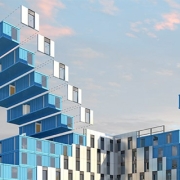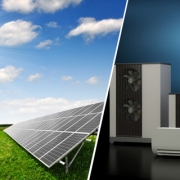Maui Wildfire Burns Down Barriers To Prefab Home Building
Reversing tradition, Hawaii’s most powerful trade union is backing the idea to allow modular homes in Hawaii.
Houses made of pre-cut lumber that can be shipped to Hawaii and built quickly. Permanent modular homes that can be literally plugged into utility infrastructure on prepared sites. Cafes, shops and food courts created out of modified shipping containers.
These are the sorts of things that could help rebuild Lahaina after the devastation of the August 8 wildfires that destroyed approximately 2,200 buildings.
In a departure from a long-standing tradition driven by Hawaii’s powerful construction industry, Governor Josh Green said:
‘Modular and prefabricated housing will play a role in creating homes quickly to serve displaced residents and the state’s most influential construction trade union is in agreement.’
“The answer’s yes,” Green said, when asked whether homes or panels built off-site and even off-island could be part of the mix to rebuild Lahaina.
“I don’t think it’s the answer for all things,” he added. “I don’t think it’s what everybody wants all the time. But I’m sure there are individuals out there now who are suffering terrible loss who would love to have a small house that could be put up quickly.”
Andrew Pereira, director of public affairs for the Pacific Resource Partnership, confirmed the organization is on board. Pereira said:
‘It is vital to build new homes quickly so island residents aren’t forced to leave — and possibly never return — for lack of housing.
PRP’s buy-in is important. The non-profit, which represents the 6,000-member Hawaii Regional Council of Carpenters and 240 general contractors, has also been one of Green’s major political supporters.
PRP has long opposed pre-made construction because of concerns developers using the products would undercut Hawaii’s construction industry – one of the few sectors that provides a consistent living wage in an economy dominated by tourism.
Maui’s tragedy has changed everything. We need to get medium-term and longer-term housing for people impacted by the tragedy, we don’t want to see Lahaina residents flee to the mainland, that’s the last thing we want to see.” Said Pereira
Green also feels the Maui fires could mark a new era.
“I think it’s safe and fair to say that because of the crisis in Maui everyone wants whatever solution is available to, as quickly as possible and to build housing that is going to provide dignity to people who live in it, even if it’s just for a couple of years,” he said.
“Whatever way we can do that we should,” he said. “I think this is probably the beginning of an era where we spend some of our energy on modular housing.”
Tom Hardiman, Executive Director of the Modular Home Builders Association and Modular Building Institute in the USA, said:
‘For a long time, homes built off construction sites involved mostly mobile homes, often used as temporary housing, which could be moved from place to place. Now, the broad category of “off-site construction” includes tiny homes, shipping-container homes and modular houses, which are similar to mobile homes but built to higher standards and designed to be permanent structures. All of these can be built elsewhere and moved to a prepared site.’
There are also pre-cut houses that can be made in a factory elsewhere, sent to Hawaii by shipping container and constructed on site.
A common aspect, Hardiman said, is that there’s a systemic process for constructing buildings and components off site.
Pereira says PRP is looking at the pre-cut home model. A key will be finding partners that can provide enough pre-cut homes to serve Lahaina’s needs.
“It really comes down to a question of scalability,” he said.
Pereira said PRP is still talking to purveyors and prefabricated homes to determine which will work best for the industry.
Costs Are Not Always Lower
One of the biggest advantages is the speed in which prefabricated and modular homes can be built, said Steve Glenn, founder and director of Plant Prefab in Los Angeles. Such houses can be built faster because some construction can be going on off site at the same time as site work. The result can cut construction time by half, which can mean a lot more homes built in less time.
Cost is another consideration. Construction costs in Hawaii are substantial. Construction costs for a union-built single-family home can be above $500 per square foot, said R.J. Martin an Oahu developer who has developed single-family homes in Nanakuli.
Vamsi Kumar Kotla, chief executive of ReMo Homes in Sherman Oaks, California, said the company could build a 1,200-square-foot modular home for $300,000, or $250 a square foot. The homes include plumbing and electrical wiring and can simply be delivered and installed on prepared sites. Kotla acknowledged that the price does not include shipping from California, which could drive up the cost significantly.
 The wildfire destroyed some 2,200 structures in Lahaina, some 85% of them homes. Will construction crews be able to rebuild fast enough to keep residents from fleeing the islands because of a lack of housing?
The wildfire destroyed some 2,200 structures in Lahaina, some 85% of them homes. Will construction crews be able to rebuild fast enough to keep residents from fleeing the islands because of a lack of housing?
It’s not just homes that could be replaced using modular methods.
UrbanBloc of San Leandro, California, converts standard shipping containers into small commercial buildings to use for restaurants, coffee shops and retail spaces. A standard 40-foot shipping container could be converted into a space for a coffee a small restaurant complete with kitchen equipment.
Even if the container buildings aren’t permanent fixtures in Lahaina, they could be stood up quickly to serve the construction workers and others who are rebuilding Lahaina and later transported somewhere else.
Construction Workers Also Will Need Housing
Which of these solutions makes its way to Hawaii in end might depend on PRP. Union carpenter jobs pay a rare living wage in Hawaii. Pereira said it’s important that modular home developers, who essentially lower costs by building houses in factories elsewhere, do not create an unfair playing field for the local workers.
Pereira added
‘Maui will need hundreds or thousands of new homes, not just for residents but also for an army of construction workers. And many of them will come from PRP, we are going to be there to provide the expert labour that’s needed to rebuild Lahaina,”
Source: Civil Beat


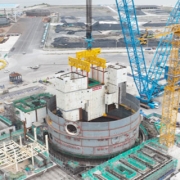
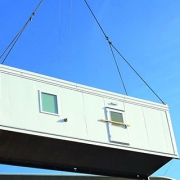




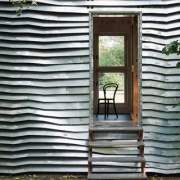
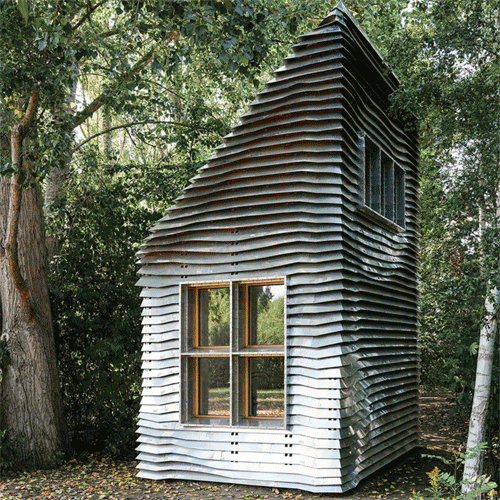 With the Digital House, Julian Krüger and Benjamin Kemper merge contemporary design and digital manufacturing techniques. The architects have crafted a sustainable and cost-effective building model that hinges on inventive plug-in construction methodologies. Situated near the Faculty of Architecture and Design at Wismar University, this humble cabin is wrapped in a fluid silver facade –constructed from repurposed aluminum sheets — and a steep, west-facing mono-pitch roof. The structure reaches a height of 6.5 meters (21 feet) atop a footprint measuring 3.3 by 4.9 meters (11 by 16 feet). The interior is illuminated by a continuous strip of windows and four large openings that cut through the facade.
With the Digital House, Julian Krüger and Benjamin Kemper merge contemporary design and digital manufacturing techniques. The architects have crafted a sustainable and cost-effective building model that hinges on inventive plug-in construction methodologies. Situated near the Faculty of Architecture and Design at Wismar University, this humble cabin is wrapped in a fluid silver facade –constructed from repurposed aluminum sheets — and a steep, west-facing mono-pitch roof. The structure reaches a height of 6.5 meters (21 feet) atop a footprint measuring 3.3 by 4.9 meters (11 by 16 feet). The interior is illuminated by a continuous strip of windows and four large openings that cut through the facade.
